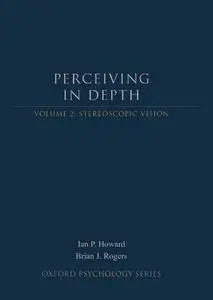P. Howard, Brian J. Rogers, "Perceiving in Depth, Volume 2: Stereoscopic Vision"
English | ISBN: 0199764158 | 2012 | 520 pages | PDF | 29 MB
English | ISBN: 0199764158 | 2012 | 520 pages | PDF | 29 MB
Perceiving in Depth is a sequel to Binocular Vision and Stereopsis and to Seeing in Depth, both by Ian P. Howard and Brian J. Rogers. This three-volume work is much broader in scope than previous texts and includes mechanisms of depth perception by all senses, including aural, electrosensory organs, and the somatosensory system. The work contains three extensively illustrated and referenced volumes. Volume 1 reviews sensory coding, psychophysical and analytic procedures, and basic visual mechanisms. Volume 2 reviews stereoscopic vision. Volume 3 reviews all mechanisms of depth perception other than stereoscopic vision. Together, these three volumes provide the most detailed review of all aspects of perceiving the three-dimensional world.
Volume 2 addresses stereoscopic vision in cats and primates, including humans. It starts with an account of the physiology of stereoscopic mechanisms. It then deals with binocular rivalry, binocular summation, binocular masking, and the interocular transfer of visual effects, such as the motion aftereffect and visual learning. Visual inputs from corresponding regions in the two eyes project to binocular cells in the visual cortex and fuse to create an impression of one image. The geometry of the region in space that creates fused images (the horopter) is discussed in some detail. Objects outside the horopter produce images with binocular disparity. Stereoscopic vision depends on the detection of these disparities after the two images have brought into correct register in the visual cortex. A review of mechanisms that bring the images into binocular register is followed by a review of stimulus tokens that are used to detect binocular disparities. A visual effect that is visible only after inputs from the two eyes have by combined is a cyclopean effect. Cyclopean effects, such as cyclopean geometrical illusions, cyclopean motion, texture segregation, and binocular direction are reviewed. a geometry of binocular vision and of mechanisms that allow us to perceive depth from binocular disparity. Stereoacuity is the smallest depth interval that can be detected. The factors that influence stereoacuity are discussed. The many types of binocular disparity, such as point disparity, orientation disparity, and spatial gradients of disparity are described. The role of each type of disparity in stereopsis is reviewed. Stimuli in distinct depth planes produce contrast effects and many visual effects, such as figure perception, motion perception, and whiteness perception, are affected by the relative distances of stimuli. These topics are reviewed. The spatiotemporal aspects of stereoscopic vision, including the Pulfrich stereomotion effect are reviewed. The volume ends with a review of techniques used to create stereoscopic displays and of the applications of stereoscopy.
some pages are missing



